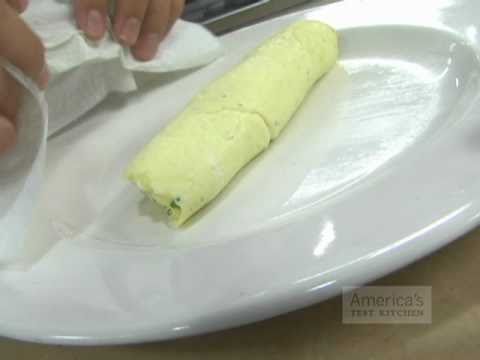One of the trickiest parts of making a french omelet is shaping it. Instead of shaping it in the pan, we use an alternative method to help us get consistent results.
Perfect French Omelets recipe:
America’s Test Kitchen is a real 2,500 square foot test kitchen located just outside of Boston that is home to more than three dozen full-time cooks and product testers. Our mission is simple: to develop the absolute best recipes for all of your favorite foods. To do this, we test each recipe 30, 40, sometimes as many as 70 times, until we arrive at the combination of ingredients, technique, temperature, cooking time, and equipment that yields the best, most-foolproof recipe.
Where to find our recipes:
Each week, the cast of America’s Test Kitchen brings the recipes, testings, and tastings from Cook’s Illustrated magazine to life on our public television series. With more than 2 million viewers per episode, we are the most-watched cooking show on public television.
More than 1.3 million home cooks rely on Cook’s Illustrated and Cook’s Country magazines to provide trusted recipes that work, honest ratings of equipment and supermarket ingredients, and kitchen tips.
Twitter:
Facebook:
source
Related posts
4 Comments
Leave a Reply Cancel reply
You must be logged in to post a comment.


I hope this video was made as a joke video cuz that is not how you make a french omelet or any omlet
Are French omelets as French as French toast? I.e. not French at all?
This omelet does not even remotely look French:
– It is a sorry flat crepe, not a fluffy omelet full of ridges created by the fork work. Eggs should be beaten not for too long, and just before starting cooking the omelet. Do not let the egg mix stand still to do some other preparation work.
– It is pale yellow instead of a beautiful golden brown from the butter.
– You appear to use a non-stick skillet, which probably does not help with the Maillard reaction. Try a seasoned blue carbon steel skillet instead. Cast iron works fine too but is not traditional for skillets in France, it is too heavy to handle frequently.
– It is rolled instead of folded in two to show the golden brown underside.
There are probably French chefs who serve omelet like you do, but it is really not the traditional French recipe. The fork work especially is essential: As soon as the underside becomes light golden, gently lift the omelet with a fork around all sides and a few times in the middle too if the skillet is large, and let the still raw egg mix that's on top go under the cooked underside. It incorporates more air and creates ridges wherever you inserted the fork, making it fluffy and look almost twice as big for the customer or guest for the same amount of eggs. The fork work usually needs to be repeated a second time.
When there is no more raw egg mix on top, or when there is only the desired amount if the customer or guest ordered their omelet "baveuse" (slimy), then fold the omelet in two with a wooden spatula in the skillet and slip it onto a warm plate. Sprinkle chives on top.
The fork work also allows to use high heat, making the omelet ready to serve in no time. Low heat as used in Normandy's Mère Michel restaurant in Mont Saint-Michel works too, but it's a different and uncommon recipe.
And yes, American "French toast" has nothing to do with French "pain perdu" (wasted bread.) It used to be made once a week from the stale "baguettes" or rather "pains" collected over the week, cut in 1 inch slices before the bread becomes too dry. The bread must be almost dried when you cook it though, so you don't use the stale bread from the same week, but from the previous weeks. There is not one dip, but two, the first one with warm sweetened milk, which will penetrate deep inside the dry bread. The second dip is just beaten eggs with a bit of salt. Then it's fried in a skillet with butter. Once the "pain perdu" is golden brown, with even a bit of dark brown on each side, the slices are transferred to a big serving plate and sprinkled with granulated sugar. No vanilla or cinnamon is used ever, just the pure taste of good milk, butter, eggs and caramelized sugar making this bread more like a brioche.
Add some more butter as you turn over the slices in the skillet, and clean the skillet from all burnt butter and pieces with a paper towel between batches.
17 eggs watched this clip
Sorry, but that's NOT a perfect omelet. Instead of jerking the pan so hard, try a gentler approach. Then it won't look like it was in a car accident.